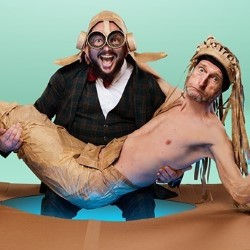Holes and Life and Times
- vilecritique
- Aug 11, 2023
- 3 min read
A comparison of two shows may be educational. JM Coeetzee’s Life and Times of Michael K and The Ice Hole are both stories about journeys: Michael traverse a landscape of chaos, where the police and rebel forces compete in atrocity escalation while The Ice Hole features couple of clowns searching for a mermaid through a world made of cardboard. It is tempting to make generalisations in both. They are, by Fringe standards, rather long and their length leads to certain weaknesses of dramaturgy. Michael K has chunks of text recited to the audience, weakly adapting the novel to the theatrical format; the ice hole repeats jokes that aren’t always that funny in the first place and wanders around Europe selecting stereotypes and presenting routine set pieces. They are, however, crowd pleasers. Like a cat twisting to have a Tommy tickle, the audience indulges playful antics of the two clowns or recognise the puppet mastery of Michael.

The seriousness of Michael K is a stark contrast to the whimsical and genial shenanigans of The Ice Hole. The Ice Hole ranges across an entire continent but only to find an imaginary being: the purpose of the show is to demonstrate how the characters exist within a world made of imaginative cardboard props and words in place of the things themselves. There is only one moment when this strays into edgy territory, when the drowning protagonist passes by migrants who have clearly been the victims of bad transportation. This is a rare breach of taste in a show that it’s almost determined to be noncontroversial and fluffy. Against this, Michael K has an urgency, seriousness, and the connection with its global context. It is a story about displacement. It is a story where violence is enacted by the state and the protagonist struggles against forces that are impersonal in their savagery.

Although there are problems with both shows, this gap, this difference, possibly speaks to something about the nature of theatre itself. The European work is free to demonstrate skilful technique and make fantasy the foundation of a show that, despite ending at the bottom of the sea, has little depth or emotional intensity. It feels as if the artists are concerned not to make a statement, which is valid, but simply to show how brilliant they are. The fantastical plot only emphasises the lack of real-world engagement. Michael K, on the other hand, contains an immediacy, a sense that this is a story that needs to be told. It explores human suffering.
Michael K is the product of the famous South African Handspring company who are best known for their work on Warhorse. Without necessarily drawing a huge conclusion about the nature of theatre made by global majorities, it seems that the European work pales into decadence against the necessity of Michael K’s story. Handspring demonstrate their mastery of puppetry – those moments when they allow the marionette to articulate the emotional thrust of the story are eloquent and emotive – but the narrative itself contains a desperate witnessing to horrors and political decay.
This year, the Fringe has decided to monitor issues of representation and race through a collaboration with the company Nouveau Riche. There is a question about why this is important: obviously, on a very basic level, representation and inclusion are tremendously important. However, these two productions suggest something about the nature of the work that is being made. In my usual tokenistic and desperate manner, I am seeing a lot of work by global majority artists. And I am beginning to wonder whether it is worth considering that these artists are not as free as European artists (and there is plenty to unpack on that statement) to be delightfully playful. And then this asks questions about the purpose of performance itself. It could be argued the work made by global majorities speaks to the importance of throwing ideas into the public sphere. Rather than being a simple matter of representation, looking at these artists may be away of engaging with the wider cultural issues and rediscovering a role for theatre in the contemporary world.



Comments